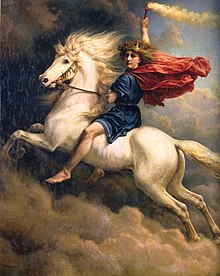Skinfaxi and Hrimfaxi
Skinfaxi and Hrimfaxi are two animal figures (horses) from Germanic mythology and legends. They embody the mounts of the gods for day and night.
Skinfaxi

Skinfaxi embodies the horse of the god Dag (day) from Nordic mythology, which pulls the sun chariot across the firmament. There are only a few written sources from Norse mythology. Skinfaxi is often referred to as a "luminous mane", since in Icelandic legends the horse of Dag does not pull a wagon with the sun, but shines itself with its mane. There is also no persecuting wolf. In these sources, Skinfaxis “love of work” is characteristic of the seasons (summer, winter). Hrimfaxi is the name of a second horse that pulls the night across the sky.
Other versions
Alternative versions were based on an independent sun goddess "Sol" and the horses Alsvidr and Arvakr (also Alswinn and Arwak, in Nordic "Allgeschwind" and "Frühwach") as two horses that pull the sun goddess Sol's chariot across the sky. The team is constantly pursued by the wolf Skalli and driven in a hurry.
Adaptations
Skinfaxi can be found in a wide range of namesake. Many Icelandic horse clubs - for example from Denmark - use the name, while in Germany a youth welfare project has chosen Skinfaxi as the name.
Hrimfaxi
Hrímfaxi ( Old Norse for "soot horse" or "the ripe mane"), also Hrimfaxi , is the horse that pulls the night across the sky in Norse mythology . Elsewhere it is said that the Nótt , that is the personification of the night, rides on the horse or that the horse pulls her cart. The foam (or saliva) of Hrímfaxis that falls on the earth in the morning forms the dew of the valleys. Then the horse Skinfaxi, which belongs to Nótt's son Dagr , pulls the day across the sky.
literature
- Rudolf Simek : Lexicon of Germanic Mythology (= Kröner's pocket edition . Volume 368). 3rd, completely revised edition. Kröner, Stuttgart 2006, ISBN 3-520-36803-X .
Individual evidence
- ^ Johannes Hoops: Reallexikon der Germanischen Altertumskunde, Volume 29 (= Johannes Hoops, Heinrich Beck [Hrsg.]: Reallexikon der Germanischen Altertumskunde ). Walter de Gruyter, 2005, ISBN 3-11-018360-9 , p. 243 ( limited preview in Google Book search).
- ^ Arnulf Krause: The songs of gods and heroes of the Elder Edda. 2004, p. 76; Simek, 2006, p. 202 only "Rußpferd"
- ↑ Lieder-Edda : Vafþrúðnismál . Verse 13 f. (Citation of the Lieder-Edda after Arnulf Krause: The Götter- und Heldenlieder der Älteren Edda. Philipp Reclam jun. Verlag, Stuttgart 2004, ISBN 978-3-15-050047-7 )
- ^ Snorri Sturluson : Prose-Edda , Gylfaginning . Chapter 10 (citation of the prose Edda after Arnulf Krause: Die Edda des Snorri Sturluson. Philipp Reclam jun. Verlag, Stuttgart 1997, ISBN 978-3-15-000782-2 )
- ↑ Lieder-Edda: Vafþrúðnismál. Verse 11 f., 14; Snorri Sturluson: Prose Edda, Gylfaginning. Chapter 10
